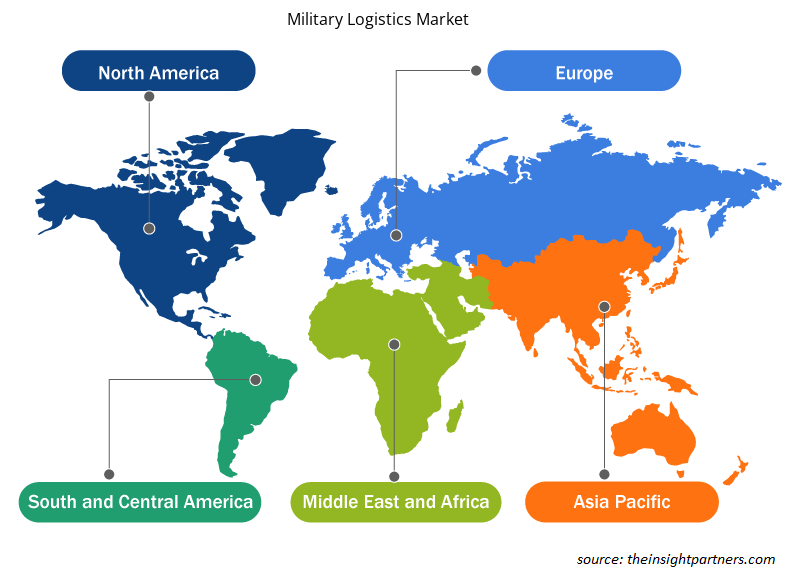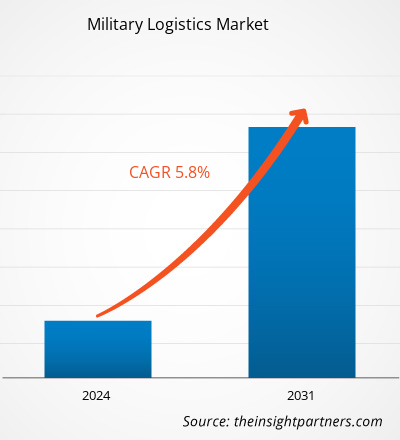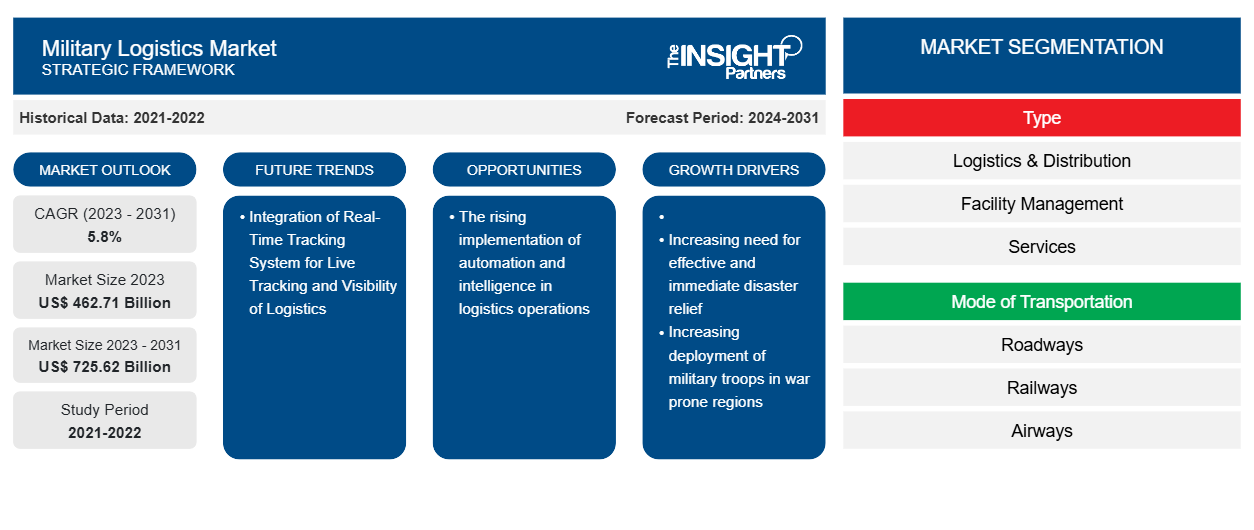Se proyecta que el tamaño del mercado de logística militar alcance los 725.620 millones de dólares en 2031, frente a los 462.710 millones de dólares en 2023. Se espera que el mercado registre una CAGR del 5,8 % durante el período 2023-2031. Es probable que la creciente implementación de la automatización y la inteligencia en las operaciones logísticas siga siendo una tendencia clave en el mercado.
Análisis del mercado de logística militar
Los compradores siguen disfrutando de un alto poder de negociación en el mercado debido a fuerzas centradas en el cliente, como la presencia de un gran número de actores del mercado, políticas favorables, reglamentaciones y directrices, y un poder adquisitivo significativamente grande de las fuerzas militares. Además, la naturaleza sensible de los componentes militares, sistemas y otros activos críticos debido a su autorización de seguridad y naturaleza confidencial ha dado lugar a un número significativamente grande de políticas, reglamentaciones y directrices logísticas para los actores del mercado. Por lo tanto, el poder de negociación general de los compradores es alto y se espera que siga siendo alto durante los próximos años.
Panorama del mercado de logística militar
En la actualidad, el mercado de la logística militar está compuesto por grandes actores establecidos con una base de clientes sustancial. Además, las grandes barreras de entrada junto con la inclinación del gobierno a recompensar la relación comercial anterior de larga data también han contribuido a la baja amenaza de nuevos participantes en el mercado de la logística militar. Sin embargo, se prevé que los recientes recortes presupuestarios, así como el aumento de la demanda de una mejor planificación, gestión y operación logística, alivien las barreras para la oferta logística seleccionada. Por ejemplo, se espera que las oportunidades para servicios mejorados relacionados con la logística, como consultoría, optimización e integración y soporte de tecnologías avanzadas junto con su soporte logístico, proporcionen barreras de entrada moderadas durante los próximos años.
Personalice este informe según sus necesidades
Obtendrá personalización en cualquier informe, sin cargo, incluidas partes de este informe o análisis a nivel de país, paquete de datos de Excel, así como también grandes ofertas y descuentos para empresas emergentes y universidades.
- Obtenga las principales tendencias clave del mercado de este informe.Esta muestra GRATUITA incluirá análisis de datos, desde tendencias del mercado hasta estimaciones y pronósticos.
Factores impulsores y oportunidades del mercado logístico militar
Necesidad creciente de ayuda inmediata y eficaz en caso de desastre
El ejército desempeña un papel vital en el apoyo a las iniciativas de ayuda humanitaria. La creciente participación del ejército en las operaciones de socorro en caso de desastre está impulsando la demanda de servicios logísticos militares eficaces. El ejército proporciona servicios como recursos materiales para proyectos de infraestructura, apoyo logístico , seguridad para los trabajadores de socorro y otros. El proveedor de logística militar debe ser rápido y eficaz para transportar los recursos necesarios a la ubicación propensa al desastre. Con la creciente participación del ejército y la demanda de servicios rápidos en los lugares de desastre, se espera que el mercado de la logística militar sea testigo de un crecimiento significativo durante el período de pronóstico.
Integración de sistema de seguimiento en tiempo real para seguimiento en vivo y visibilidad de la logística
Los proveedores de logística militar están integrando soluciones inteligentes para el seguimiento y la visibilidad de las mercancías en tiempo real. El sistema de seguimiento en tiempo real incluye GIS, RFID y otras soluciones. La logística militar tiene que coordinar el movimiento de múltiples vehículos militares, equipos, carga y otros. Con la integración de la tecnología GIS, genera mapas detallados para identificar rutas óptimas, condiciones meteorológicas y de la carretera, y otra información. También rastrea vehículos en tiempo real con el contenido exacto del envío. También proporciona capacidades de respuesta a emergencias. Para garantizar el movimiento seguro y protegido de la carga, los proveedores están muy centrados en la implementación de estas tecnologías. Se espera que la demanda de sistemas de seguimiento en tiempo real y otras soluciones de seguridad avanzadas aumente durante el período de pronóstico junto con otros servicios logísticos y será una gran oportunidad para los proveedores que operan en el mercado de logística militar.
Análisis de segmentación del informe del mercado de logística militar
Los segmentos clave que contribuyeron a la derivación del análisis del mercado de logística militar son el tipo y el modo de transporte.
- Según el tipo, el mercado de logística militar se segmenta en logística y distribución, gestión de instalaciones y servicios. El segmento de logística y distribución tuvo una mayor participación de mercado en 2023.
- Según el modo de transporte, el mercado de logística militar se segmenta en carreteras, ferrocarriles, vías aéreas y vías fluviales. El segmento de carreteras tuvo una mayor participación de mercado en 2023.
Análisis de la cuota de mercado de la logística militar por geografía
El alcance geográfico del informe del mercado de logística militar se divide principalmente en cinco regiones: América del Norte, Europa, Asia Pacífico, Medio Oriente y África y América del Sur.
Asia Pacífico ha dominado el mercado en 2023, seguida de las regiones de Europa y América del Norte. Además, es probable que Asia Pacífico también sea testigo de la CAGR más alta en los próximos años. China dominó el mercado de logística militar de Asia Pacífico en 2023. Además, la guerra en curso en las regiones de Europa y Medio Oriente también ha afectado la demanda de logística militar en dichas regiones. La guerra entre Rusia y Ucrania, Israel y Palestina y la participación de otros países en tales guerras están impulsando la demanda de logística militar, ya que hay muchas tropas desplegadas en múltiples ubicaciones en Europa y los países de Medio Oriente. Estos factores han impulsado el crecimiento del mercado de logística militar en diferentes regiones.
Perspectivas regionales del mercado de logística militar
Los analistas de Insight Partners explicaron en detalle las tendencias y los factores regionales que influyen en el mercado de logística militar durante el período de pronóstico. Esta sección también analiza los segmentos y la geografía del mercado de logística militar en América del Norte, Europa, Asia Pacífico, Oriente Medio y África, y América del Sur y Central.

- Obtenga datos regionales específicos para el mercado de logística militar
Alcance del informe sobre el mercado de logística militar
| Atributo del informe | Detalles |
|---|---|
| Tamaño del mercado en 2023 | US$ 462,71 mil millones |
| Tamaño del mercado en 2031 | US$ 725,62 mil millones |
| CAGR global (2023 - 2031) | 5,8% |
| Datos históricos | 2021-2022 |
| Período de pronóstico | 2024-2031 |
| Segmentos cubiertos | Por tipo
|
| Regiones y países cubiertos | América del norte
|
| Líderes del mercado y perfiles de empresas clave |
|
Densidad de actores del mercado de logística militar: comprensión de su impacto en la dinámica empresarial
El mercado de logística militar está creciendo rápidamente, impulsado por la creciente demanda de los usuarios finales debido a factores como la evolución de las preferencias de los consumidores, los avances tecnológicos y una mayor conciencia de los beneficios del producto. A medida que aumenta la demanda, las empresas amplían sus ofertas, innovan para satisfacer las necesidades de los consumidores y aprovechan las tendencias emergentes, lo que impulsa aún más el crecimiento del mercado.
La densidad de actores del mercado se refiere a la distribución de las empresas o firmas que operan dentro de un mercado o industria en particular. Indica cuántos competidores (actores del mercado) están presentes en un espacio de mercado determinado en relación con su tamaño o valor total de mercado.
Las principales empresas que operan en el mercado de logística militar son:
- AECOM
- Código de zona franca de ANHAM
- Aselsan AS
- PLC de BAE Systems
- DynCorp Internacional LLC
Descargo de responsabilidad : Las empresas enumeradas anteriormente no están clasificadas en ningún orden particular.

- Obtenga una descripción general de los principales actores clave del mercado de logística militar
Noticias y desarrollos recientes del mercado logístico militar
El mercado de la logística militar se evalúa mediante la recopilación de datos cualitativos y cuantitativos a partir de una investigación primaria y secundaria, que incluye importantes publicaciones corporativas, datos de asociaciones y bases de datos. A continuación se enumeran algunos de los avances en el mercado de la logística militar:
- El Ministerio de Defensa ha anunciado hoy su intención de firmar un contrato de programa logístico de 13 años con Leidos tras unas negociaciones exitosas. (Fuente: Leidos, Nota de prensa, marzo de 2015)
- Un nuevo contrato de cinco años por 460 millones de libras con Boeing Defense UK respaldará un sistema logístico fundamental para las operaciones de las Fuerzas Armadas del Reino Unido en todo el mundo. (Fuente: Ministerio de Defensa del Reino Unido, comunicado de prensa, enero de 2021)
Informe sobre el mercado de logística militar: cobertura y resultados
El informe “Tamaño y pronóstico del mercado de logística militar (2021-2031)” proporciona un análisis detallado del mercado que cubre las siguientes áreas:
- Tamaño del mercado de logística militar y pronóstico a nivel global, regional y nacional para todos los segmentos clave del mercado cubiertos bajo el alcance
- Tendencias del mercado de logística militar, así como dinámicas del mercado, como impulsores, restricciones y oportunidades clave
- Análisis detallado de las cinco fuerzas de Porter
- Análisis del mercado de logística militar que abarca las tendencias clave del mercado, el marco global y regional, los principales actores, las regulaciones y los desarrollos recientes del mercado.
- Análisis del panorama de la industria y de la competencia que abarca la concentración del mercado, el análisis de mapas de calor, los actores destacados y los desarrollos recientes del mercado de logística militar
- Perfiles detallados de empresas
- Análisis histórico (2 años), año base, pronóstico (7 años) con CAGR
- Análisis PEST y FODA
- Tamaño del mercado, valor/volumen: global, regional y nacional
- Industria y panorama competitivo
- Conjunto de datos de Excel
Informes recientes
Informes relacionados
Testimonios
Razón para comprar
- Toma de decisiones informada
- Comprensión de la dinámica del mercado
- Análisis competitivo
- Información sobre clientes
- Pronósticos del mercado
- Mitigación de riesgos
- Planificación estratégica
- Justificación de la inversión
- Identificación de mercados emergentes
- Mejora de las estrategias de marketing
- Impulso de la eficiencia operativa
- Alineación con las tendencias regulatorias





















 Obtenga una muestra gratuita para - Mercado de logística militar
Obtenga una muestra gratuita para - Mercado de logística militar